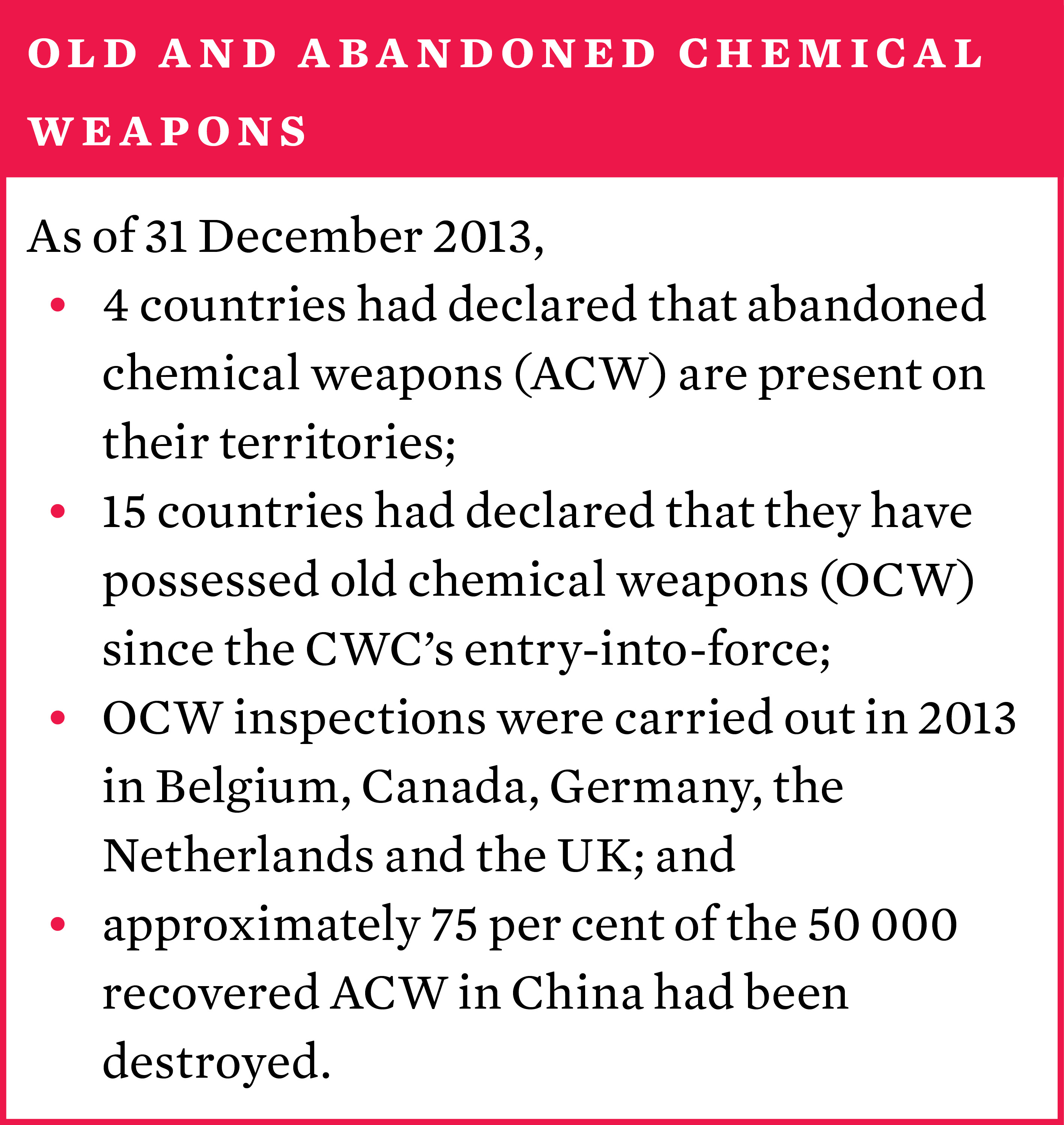8. Reducing security threats from chemical and biological materials
Contents
- Overview [PDF]
JOHN HART
- I. Chemical and biological weapon programmes [PDF]
JOHN HART
- II. Chemical weapon arms control and disarmament [PDF]
JOHN HART
- III. Biological weapon arms control and disarmament [PDF]
JOHN HART
- IV. Oversight of dual-purpose research in the life sciences [PDF]
PETER CLEVESTIG AND JOHN HART
Summary
In 2013 states continued to develop strategies to prevent and remediate the effects of the possible misuse of toxic chemicals and of biological materials. Some of these activities are carried out in the context of environmental and human health, while others are done in the security and defence spheres. The principal legal instruments against chemical and biological warfare (CBW) are the 1993 Chemical Weapons Convention (CWC) and the 1972 Biological and Toxin Weapons Convention (BTWC). They inform the consideration of CBW threats and responses, understanding of past programmes, allegations of the use of biological or chemical weapons, the nature of possible standby programmes, and efforts to ensure that science and technology are not misused for hostile purposes or as a method of warfare.
Destruction of chemical weapons
As of 31 December 2013,
- Iraq, Libya, Syria, Russia and the USA had yet to complete destruction of their chemical weapon stockpiles;
- 58 528 tonnes (81 per cent) of category 1 chemical weapons had been destroyed;
- 14 states had declared 96 former chemical production facilities; and
- 43 of these facilities had been destroyed and 22 converted to peaceful purposes.
Syria
The most significant developments concerning security threats from chemical or biological materials in 2013 related to Syria. After the Syrian Government’s admission in 2012 that it possessed chemical weapons, in 2013 a series of increasingly serious allegations, threats of military intervention and attempted international investigation eventually led to an international inspection team, working under the auspices of the United Nations Secretary-General, entering Syria. Its report, which confirmed the use of chemical weapons in the civil war without specifying which side had used them, led to Syria becoming a party to the CWC.
As a CWC party, Syria made a formal declaration of its stockpiles of chemical weapons and reached agreement on their removal from its territory and destruction. A multifaceted and evolving verification effort was carried out under a cooperative arrangement involving the UN Office for Disarmament Affairs (UNODA), the Organisation for the Prohibition of Chemical Weapons (OPCW), the World Health Organization (WHO) and other bodies, including national laboratories. However, the Syrian Government continued to deny that it had used chemical weapons and did not mention in its initial declaration any weapons of the two types identified by the international inspectors as having been used at Ghouta on 21 August.
Chemical weapon arms control and disarmament
The Third Review Conference of the CWC and the 18th Conference of the States Parties received significant international prominence, partly as a result of attention to the continued worsening conflict in Syria and the decision by the United States not to attack Syria for its chemical weapon use in exchange for verified chemical weapon disarmament.
The US administration had repeatedly indicated in preceding months that the use of chemical weapons in the conflict would constitute a ‘red line’ and would lead to ‘serious consequences’—widely understood to mean the use of military force.
In 2013 the OPCW won the Nobel Peace Prize ‘for its extensive efforts to eliminate chemical weapons’.
Biological weapon arms control and disarmament
The states parties to the BTWC met twice during 2013 in the second of a series of four intersessional meetings of experts and parties agreed by the 2011 Seventh Review Conference. The meetings focused on science and technology developments and on confidence-building measures—in particular, on whether and how to establish states parties’ compliance with the convention.
Oversight of dual-purpose research in the life sciences
Developments in dual-purpose research in the life sciences—that is, scientific research that has potential military applications—included the ending of the long-running Russian–US Cooperative Threat Reduction (CTR) programme, the recent focus of which has been on biological threat reduction.
Researchers who discovered a new botulinum neurotoxin chose not to submit the sequence data to a public repository of nucleotide sequences until an effective antitoxin has been developed because of the toxin’s serious risks to public health. The threat posed by public availability of such a nucleotide sequence was illustrated by the announcement of a project to develop the biological equivalent of a three-dimensional (3D) printer, which might eventually be used to sequence pathogenic microorganisms.
